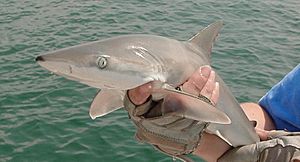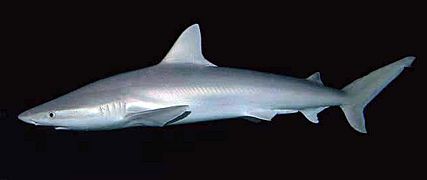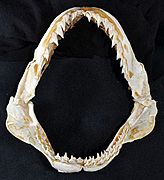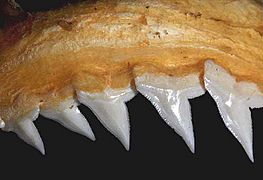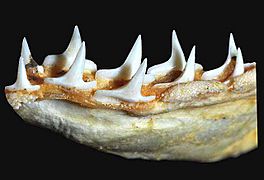Blacknose shark facts for kids
Quick facts for kids Blacknose shark |
|
|---|---|
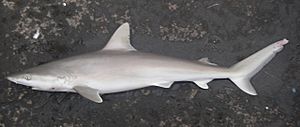 |
|
| Conservation status | |
| Scientific classification | |
| Kingdom: | |
| Phylum: | |
| Class: | |
| Order: | |
| Family: | |
| Genus: | |
| Species: |
C. acronotus
|
| Binomial name | |
| Carcharhinus acronotus |
|
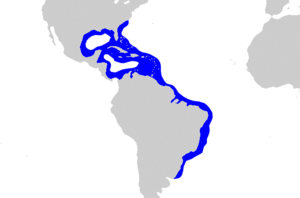 |
|
| Range of the Blacknose shark | |
The Blacknose shark (Carcharhinus acronotus) is a type of shark found along the eastern coasts of North and South America. These sharks usually live in coastal waters. You can find them near seagrass beds, sandy areas, or places with shells and coral. Blacknose sharks are quite small. Grown-up sharks are usually about 4.6 feet (1.4 meters) long. This shark gets its name from a small black spot on the tip of its snout.
Contents
What Does the Blacknose Shark Look Like?
Blacknose sharks are small and slender. They have a long, rounded snout and big eyes. The black spot under the tip of their snout helps you tell them apart from other sharks.
These sharks have two dorsal fins (fins on their back). The first dorsal fin is above their pectoral fins (side fins). The second dorsal fin is near their anal fin (fin on their belly). The Blacknose shark does not have a ridge between its dorsal fins.
Their bodies are grey to greenish-grey. The tips of their second dorsal fin and the upper part of their tail fin are black.
Teeth of the Blacknose Shark
The Blacknose shark has many rows of teeth. In its upper jaw, it has 12 to 13 rows of teeth on each side. The lower jaw has 11 to 12 rows. The teeth in the upper jaw are narrow and triangular. They have rough edges near the bottom. The teeth in the lower jaw also have rough edges but are wider at the bottom.
Size and Growth
An average adult Blacknose shark is about 4.1 feet (1.2 meters) long. The biggest ones can reach 4.6 feet (1.4 meters). They usually weigh around 22 pounds (10 kg) when fully grown. These sharks grow quite fast. Both male and female sharks become adults when they are about 3.3 feet (1 meter) long.
Where Do Blacknose Sharks Live?
Blacknose sharks live along the eastern coast of the Americas. You can find them from North Carolina in the United States all the way down to southern Brazil. They also live in the Bahamas, the Gulf of Mexico, and the Caribbean Sea.
They prefer shallow coastal waters. These areas often have seagrass beds, sandy flats, or places with shells and coral. Younger sharks are usually found in very shallow water. Adult sharks prefer deeper water, usually more than 30 feet (9 meters) deep. They are most common at depths of 59–210 feet (18–64 meters).
Shark Migration
Blacknose sharks living off the Atlantic coast of the southern United States move around. They travel north in the summer and south in the winter. Sharks in the Gulf of Mexico do a similar migration.
How Do Blacknose Sharks Reproduce?
Blacknose sharks give birth to live young, just like mammals. They mate in late May and early June. The mother shark carries her babies for about 10 to 11 months.
Scientists have noticed that Blacknose sharks in different areas have different breeding habits. Female sharks in the Gulf of Mexico seem to have babies every year. However, females in the Atlantic Ocean might have babies only once every two years.
A mother Blacknose shark usually has 3 to 6 pups in one litter. The most common number is 4 pups. When they are born, the young sharks are about 17–20 inches (43–51 cm) long. Both male and female sharks become adults when they are about 2 years old. One important place where these sharks have their babies is Bulls Bay in South Carolina, United States.
What Do Blacknose Sharks Eat?
The Blacknose shark is a very fast swimmer. It hunts and eats small fish. Some of its favorite foods include pinfish, croakers, porgies, anchovies, spiny boxfish, and porcupine fish. They also like to eat octopus.
How Do Blacknose Sharks Interact with Humans?
Blacknose sharks are not a big part of commercial fishing. However, some people like to catch them for sport. They are known to put up a good fight when caught. When these sharks are caught, their meat is sometimes dried and sold for people to eat.
These sharks are generally not dangerous to humans. There have been no reported cases of a Blacknose shark attacking a person. However, if a diver gets too close, the Blacknose shark might show a "threat display." This means it will hunch its back, raise its head, and lower its tail to warn the diver to stay away.
Images for kids
See also
 In Spanish: Tiburón de morro negro para niños
In Spanish: Tiburón de morro negro para niños



